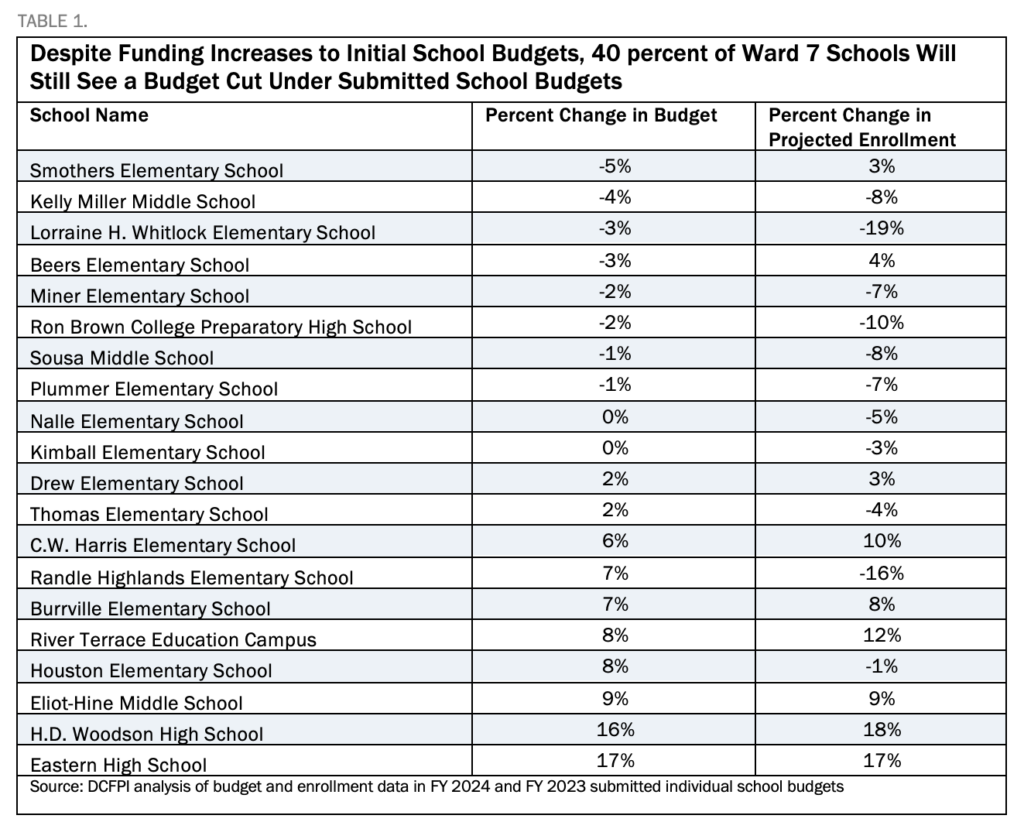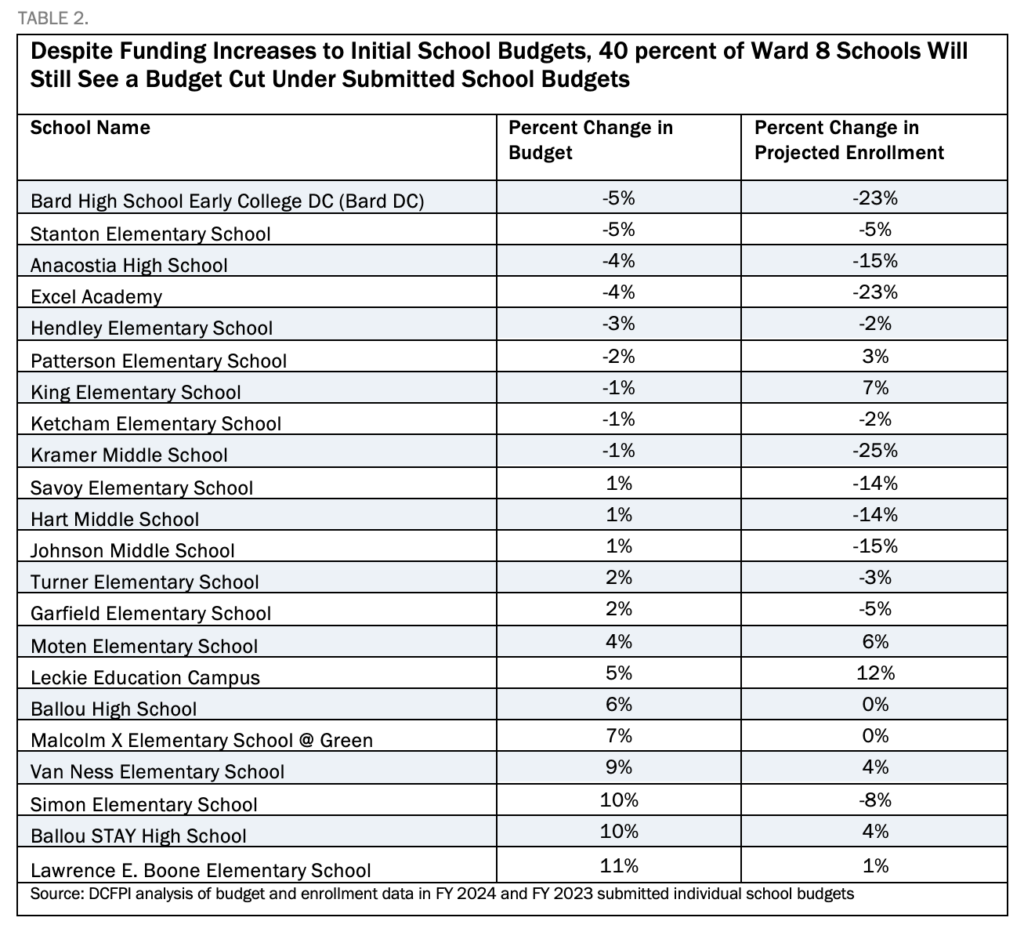Chairperson Mendelson, members of the Committee, and Committee staff, thank you for the opportunity to testify. My name is Michael Johnson, State Policy Fellow at the DC Fiscal Policy Institute (DCFPI). DCFPI is a non-profit organization that shapes racially-just tax, budget, and policy decisions by centering Black and brown communities in our research and analysis, community partnerships, and advocacy efforts to advance an antiracist, equitable future.
Today, I would like to discuss DCFPI’s analysis of the fiscal year (FY) 2024 submitted school budgets for DC Public Schools (DCPS). Given reoccurring troublesome trends in budgets and enrollment in schools in Wards 5, 7, and 8—which serve a majority of Black and brown students and students from families with low incomes—our analysis focuses on these wards. Key observations within our analysis include the following:
- Nearly every school within these wards saw a budget increase, compared to their initial school budgets. On average, schools received just over $100,000 in additional funding.
- Despite additional funding relative to school initial budgets, 38 percent of schools in Wards 5, 7 and 8 will receive less funding compared to their FY 2023 submitted budget.
- Of the schools facing budget declines compared to the year prior, the vast majority— 70 percent—are elementary schools.
- All schools with budget reductions are receiving at least 95 percent of their prior year budget inclusive of all recurring, one-time, local, and non-local funding sources.
Despite Funding Increases, Elementary Schools Across Wards 5, 7 & 8 are Facing the Bulk of Budget Cuts Compared to the Previous Year.
For DCPS schools in Wards 5, 7, and 8, 38 percent are facing a cut under the mayor’s proposed FY 2024 submitted school budgets compared to the FY 2023 submitted budgets. This is despite schools receiving an additional , on average, relative to their initial school budgets released in February, largely driven by additional need identified at the individual school level as well as small increases in Title 1 parental engagement funding.[1] By-and-large, students in earlier grades will bear the brunt of funding losses compared to the year prior. Of the 20 schools in these wards facing a budget cut, 70 percent are elementary schools.[2]
Given the relationship between enrollment and school funding in the DCPS student-based budgeting model, one would expect to see a more direct association between enrollment and funding changes. is confusing and reflects potential inconsistencies in how DCPS applies its school funding model. Yet, further analysis of projected enrollments for specific student groups, such as students receiving special education (SPED) services, English Learners (EL), and students designated “at-risk” of academic failure suggests that some of the inconsistencies are, in part, attributable to changes in the composition of schools’ populations. DCPS funds students in these categories at a higher per-student amount. Therefore, while a school may be projected to lose students on net, the school could be gaining SPED, EL, or at-risk students that would result in a budget increase. Similarly, a school could be gaining students on net, but be projected to lose SPED, EL, or at-risk students, causing the school to lose more money given those students carry a higher funding amount.
However, for many elementary schools, loss of funding cannot be fully explained with the observable student population data, even when accounting for specific student groups. For example, of the 20 schools facing a budget reduction, four are projecting enrollment increases for students overall as well as across every specific student group (at-risk, EL, & SPED)—all of which are elementary schools. Beers Elementary school is indicative of this issue as they are expected to lose more than $207,000 yet projecting overall enrollment to increase by 4 percent, at-risk enrollment to increase by 11 percent, EL enrollment to increase by one student, and SPED enrollment to increase by 1 percent.[3]
DCFPI encourages DCPS to improve transparency and better explain why some schools’ budgets are increasing or decreasing, particularly if DCPS is using any discretion to pivot away from the formula for a particular school. The current format of publicly available budget documents makes it difficult for the public to discern why and how a school’s budget could be decreasing even if enrollment is growing or remains unchanged.
DCPS Needs a Plan for School Budgets Receiving One-Time Funds
Schools in Wards 7 and 8 are the most likely to face a fiscal cliff in FY 2025 due to the loss of one-time funding absent proactive planning from policymakers. Our analysis shows that six schools across Wards 5,7, and 8 have submitted budgets in which stability funding makes up five or more percent of the school’s budget. Stabilization and safety net supplement funding, two categories of stability funding in FY 2024 initial budgets, are recurring sources that DCPS provides to schools. However, stability funding from the mayor’s Recovery Fund is one-time funding, and FY 2024 is the final year of the fund. Twelve schools receive mayor’s Recovery Funds, with 11 of those being in Wards 7 and 8have submitted budgets in which this funding makes up at least five percent of their budget, a sizeable loss that would carry consequences for children already the furthest from opportunity. Sousa Middle School in Ward 7 has the largest percentage of its budget made up of one-time stability funding at 8 percent.
Lawmakers should be proactively planning for how it will protect these and other schools relying on one-time stability funding from experiencing a sharp fiscal cliff moving forward. Figuring this out next budget season will be too late.
DCPS Is Trying to Stabilize School Budgets Despite Significant Declines in Projected Enrollment
Two things can be true at the same time: students deserve more and targeted resources to reach their full potential and steep enrollment declines in certain communities undermine the DCPS’s ability to provide more and targeted resources to students. In FY 2020, DCPS issued initial school budgets in which 85 percent of the school budgets that were decreasing by more than five percent were concentrated in Wards 7 and 8. Many of those schools were projected to experience sharp declines in enrollment. While DCPS is ensuring that schools receive at least 95 percent of their prior year’s budget—again, partly via non-recurring stability funding— enrollment at schools in Wards 7 and 8 will decline by more than 500 students combined compared to last year, with some schools expected to lose almost a quarter of their enrollment (Tables 1 and 2).
The enrollment projections in the figures above are alarming and deserve thoughtful budget and policy responses. These schools are serving high percentages of students who are designated at-risk, and they tend to have higher SPED populations than schools in whiter, wealthier parts of the District. These are schools that need more, not fewer resources yet ongoing enrollment loss continues to threaten that possibility.
DCFPI has previously testified on how DCPS could explore adding a new weight to its funding model for schools with below average enrollments, whose funding is more sensitive to enrollment fluctuations. The addition of such a weight could especially help small schools by reducing their need to rely on their at-risk and other targeted support funding to cover basic educational costs. Even still, more action is needed to address the disturbing enrollment trends in Ward 7 and 8 schools.
To truly address school budget stability, DCFPI urges the Mayor, DC Council, and education officials to articulate and demonstrate an equitable vision for and commitment to neighborhood schools. DC children and families should not have to wait any longer for District leaders to act. Failure to remedy concentrated enrollment declines at schools in Wards 7 and 8 and budget inconsistencies—particularly at the elementary school level—is irresponsible and undermines DC’s promise of a high-quality public education to all students.


